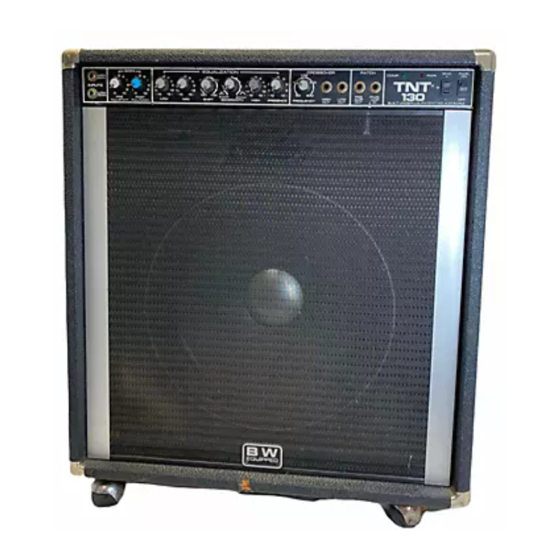
Advertisement
Quick Links
TNT 130
Operating Guide
INTRODUCTION AND GENERAL DESCRIPTION
Congratulations on your purchase of the Peavey TNT'" 130 bass amplification system. After reading this
owner's manual you will have a better understanding of the operating principles of the system. A thorough
understanding of these instructions will also help you to achieve many varied tonal settings.
The TNT'" 130 isa highlyadvanceG, 130 watt bass system utilizing the latest active equalization circuitry, built-in
variable crossover network, patching facilities, a tuned and ported enclosure and a very efficient 15" loudspeaker.
(As an option, the TNT™ 130 is available with a premium Black Widow®/Super Structure"* transducer model #1502-
4.) The TNT'" 130 also employs our patented DDT™ (Distortion Detection Technique) compression circuit (U.S.
Patent #4,318,053) which automatically detects the onset of clipping (distortion) at the power amp. Not only does
this novel circuit help prevent speaker damage/failure, it also aids in reproducing the ultra clean sounds for today's
bass and keyboard styles.
As with any sophisticated piece of equipment, there are some operating principles concerning the input stage,
gain controls, equalization and patching facilities which must be understood to obtain the best tonal results. Please
read and understand this manual and keep it handy for future reference.
TNT™ 1 30 SPECIFICATIONS
POWER AMPLIFIER SECTION:
RATED POWER & LOAD:
130 W RMS into 4 ohms with DDT'" compression
POWER @ CLIPPING: (TYPICALLY)
(5% THO, 1 KHz. 120 VAC line)
85 W RMS into 8 ohms
140 W RMS into 4 ohms
2 ohms not recommended
FREQUENCY RESPONSE:
*0. -1 dB. 20 Hz to 20 KHz @ 100 W RMS into 4 ohms
TOTAL HARMONIC DISTORTION:
Less than 0.2%. 100 mW to 100 W RMS. 20 Hz to 10 KHz.
4 ohms, typically below 0 1%
DDT'" DYNAMIC RANGE:
Greater than 20 dB
DDT " MAXIMUM THD:
Below 0.5% THD for 6 dB overload
Below 1% THD for 20 dB overload
HUM & NOISE:
Greater lhan 95 dB below rated power
POWER CONSUMPTION: (Domestic)
30 watts. 50/60 Hzm 120 VAC
PREAMP SECTION:
THE FOLLOWING SPECS ARE MEASURED @ 1 KHz
WITH THE CONTROLS PRESET AS FOLLOWS:
PRE GAIN PULL BRIGHT OFF (IN)
POST GAIN PULL PUNCH OFF (IN)
POST GAIN @ 10
LOW EO @ -6 dB
MID EO @ -6 dB
SHIFT O 300 Hz
BANDWIDTH
@
12:00
HIGH (5) +9 dB
PRESENCE @0 dB
NOMINAL LEVELS ARE WITH PRE GAIN @ 5
MINIMUM LEVELS ARE WITH PRE GAIN @ 10
PREAMP HIGH GAIN INPUT:
Impedance: High Z. 220K ohms
Nominal Input Level: -30 dBV. 30 mV RMS
Minimum Input Level -46 dBV. 5 mV RMS
Maximum Input Level: +8 dBV. 2.5 V RMS
PREAMP LOW GAIN INPUT:
Impedance: High Z. 44K ohms
Nominal Input Level: -24 dBV 60 mV RMS
Minimum Input Level: -40 dBV. 10 mV RMS
Maximum Input Level: *-14 dBV, 5 V RMS
CROSSOVER HIGH OUTPUT:
Function: High pass out
Load Impedance: IK ohms or greater
Nominal Output: 0 dBV. 1 V RMS
Maximum Output: *18 dBV, 8 V RMS
CROSSOVER LOW OUTPUT:
Function: Low pass out
Load Impedance: IK ohms or greater
Nominal Output: 0 dBV. 1 V RMS
Maximum Output: +18 dBV, 8 V RMS
PREAMP OUTPUT:
Function: Full range out
Load Impedance: IK ohms or greater
Nominal Output: 0 dBV, 1 V RMS
Maximum Output: +18 dBV. 8 V RMS
POWER AMP INPUT:
Impedance: High Z. 22K ohms
Designed Input Level: 0 dBV. 1 V RMS
(Switching jack providing preamp output to power amp
input connection when not used)
SYSTEM HUM & NOISE @ NOMINAL INPUT LEVEL:
(20 Hz to 20 KHz unweighted)
78 dB below rated power
EQUALIZATION:
Low & High: +-15 dB (® 80 Hz & 3 KHz, shelving
Mid- —15 dB (with shift
&
bandwidth), peak/notch
Shift: 150 Hz to 1500 Hz
Bandwidth: 1/3 to 3 octaves
Presence: +-15 oB (Special EO)
Pull Bright: *6 dB @ 2 KHz
Pull Punch: Special EQ
CROSSOVER: (FOR BI-AMP APPLICATIONS)
Range: 50 Hz to 500 Hz
Slope: i2dB/octave
WARNING
TO PREVENT ELECTRICAL SHOCK OR FIRE HAZARD, DO NOT EXPOSE THIS APPLIANCE TO RAIN OR MOISTURE.
BEFORE USING THIS APPLIANCE. READ BACK COVER FOR FURTHER WARNINGS.
Advertisement









Need help?
Do you have a question about the TNT 130 and is the answer not in the manual?
Questions and answers